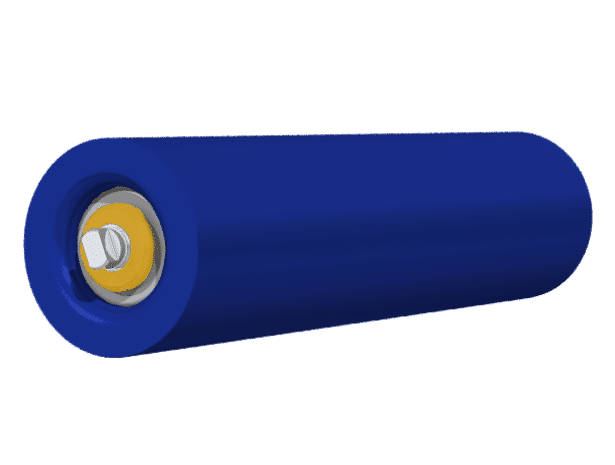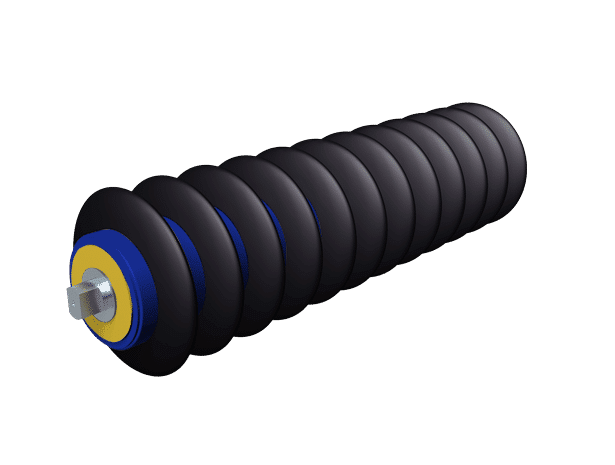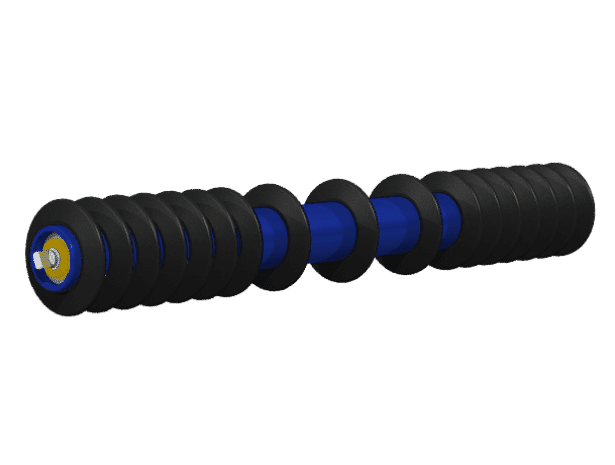CONVEYOR ROLLER AND TRANSPORTER ROLLER
Discover our complete range of conveyor rollers

Flat roller

impact roller

Anti-clogging roller
Special rolls
The conveyor roller, an indispensable component of the belt conveyor.
The conveyor roller is a key component of a belt conveyor. Used to support the conveyor belt and the weight of the materials being transported, it is available in several forms.
It is used most of the time for conveying materials. It is found in mining and quarries. It is mainly used to transfer payload from a conveyor belt. It guides the belt and transports the material without tipping. The most common conveyor rollers are the handling roller, the impact roller and the rubber-lagged roller. The conveyor roller is used to support the conveyor belts and the weight of the objects passing over them.
ROLLDRUM can help you calculate and size your conveyor rollers. ROLLDRUM offers complete design services to provide customized conveyor rollers to perfectly meet your requirements and guarantee optimum performance.
Call us :
+33 1 85 53 73 80

IMPACT ROLLER
The impact roller is installed at the material infeed and outfeed points to reduce impact on the belt and improve belt life. The design prevents shocks when materials are thrown onto the belt. The impact roller is a key element of a belt conveyor, absorbing the movement of materials on the belt. It is widely used in the metallurgy, mining, port and dock, chemical, energy, cement, coal and steel industries.
The ROLLDRUM conveying roller is adapted to meet the requirements of every application: sealing, extreme climatic conditions, heavy loads, high speed, noise, special chemical conditions…
ANTI-CLOGGING ROLLERS
The anti-clogging roller is an important part of the belt conveyor. The conveyor belt roller can effectively reduce friction with the conveyor belt, thus extending its service life. It is widely used in various fields, such as mining, cement, chemical and building materials plants. Efficient and compact, it improves the transfer of bulk materials.


MINING ROLLER
The mining roller is a major component of a conveyor belt. Our range of rollers features low rolling resistance, perfect concentricity, low noise levels during operation, and a tight seal perfectly suited to harsh conditions, as well as to the most common applications.
FLAT ROLLER
The flat roller is a major component of a belt conveyor. Our range of conveyor rollers features low rolling resistance, perfect concentricity, low noise levels during operation and a seal perfectly suited to harsh conditions.
ROLLDRUM conveyor rollers feature sealing technology for the most common applications. Combined with the right choice of grease, the sealing technology used is one of the most effective on the market.

SPIRAL ROLLER
The DSC or DSA rubber-lagged spiral roller is a specific product. Installed on the return side of the belt, it cleans the belt when it is extremely polluted.
There are 2 types of helical rubber-lagged rollers:
- with rubber-lagged coils
- steel-wound. Steel spirals are more efficient, but also wear the belt more quickly.
RUBBER-LAGGED ROLLER
The rubber-lagged roller reduces resistance to skidding, impact and abrasion.
The chemical resistance of the high-density polyethylene (HDPE) used in the rubber-lagged roller makes it virtually chemically inert. Combined with stainless steel elements (optional), it can be used in the most corrosive environments. The reduced weight of this handling roller reduces energy consumption and makes it more economical for overhead conveyors, belt conveyors with difficult access and long conveyors. This type of conveyor roller is also anti-clogging, as HDPE is self-cleaning (no more product build-up around the roller). The flexibility offered by this material limits operating noise. Depending on the type of rubber-lagged used, it may be compatible with food environments.
RETURN ROLLER
A return roller is an important component of a belt conveyor. It is used to support the conveyor belt in the return section to reduce rubber wear and prevent deterioration. It ensures that moving parts remain stationary while allowing the belt to move smoothly.
TACHOMETRIC ROLLER
The tachometric roller controls rotation by means of a speed sensor.
This is a monitoring roller for belt conveyor protection. The speed sensor is installed in place of a lift, and the electronic unit provides an adjustable speed threshold. The tachometric roller is supplied with a ring for length adjustment. The speed information is retransmitted in the form of a variable-frequency electrical pulse. As an option, the tachometer roller can be fitted with a support adapter for mounting on 1000 and 1200 mm conveyors.
GUIDE ROLLER
Guide rollers, essential for belt conveyors, ensure alignment and reduce wear on the belt, thus extending its service life. Their selection depends on load, environment and travel speed. Proper maintenance, including cleaning, inspection and lubrication, is crucial. ROLLDRUM rollers offer optimum performance for centering stations.
CARRIER ROLLER
Carrier rollers are vital for belt conveyors, supporting the weight of materials and reducing wear. They ensure efficient, economical transport, and are designed to withstand wear and impact. Regular maintenance is essential to prevent the build-up of impurities, guaranteeing optimum longevity and performance. These rollers are indispensable in various industrial sectors for their versatility and durability.
HEAVY-DUTY ROLLER
Heavy-duty rollers are essential in belt conveyor systems, playing a crucial role in the transport of heavy materials. With their robust design, these rollers stand out for their ability to support heavy loads, helping to reduce wear and extend conveyor life.
HANDLING ROLLER
Conveyor rollers are essential to the operation of belt conveyors, used in various sectors such as mining and food processing. These components reduce friction and ensure smooth transmission of loads, increasing the performance and durability of conveyor systems.
SELF-CENTERING ROLLER
The self-centering roller is crucial to the smooth operation of belt conveyors. It ensures correct centering of the conveyor belt, preventing wear and disruption to the industrial process. These rollers feature automatic re-centering mechanisms to keep the belt aligned.
The conveyor roller is a key component of a belt conveyor. Used to support the conveyor belt and the weight of the materials being transported, it is available in several forms.
It is used most of the time for conveying materials. It is mainly found in mining and quarries. It is mainly used to transfer payload from a conveyor belt. It guides the belt and transports the material, preventing it from tipping over.
Belt conveyors are most often used by large-scale industries to transport grain, minerals and other granular or pulverized materials. They are usually equipped with a variety of idler rollers to better support and transfer materials. They reduce belt noise and stabilize the conveyor structure.
ROLLDRUM operates in a wide range of sectors, including mining, ports, quarries and the food industry.
Whatever your sector, ROLLDRUM’s comprehensive range of products offers innovative solutions to your handling problems.